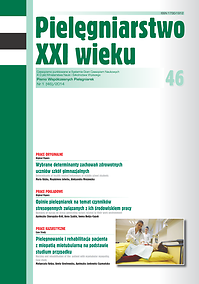Rola niezbędnych nienasyconych kwasów tłuszczowych oraz ich znaczenie w wybranych schorzeniach
Słowa kluczowe:
kwasy tłuszczowe omega-3, kwasy tłuszczowe omega-6, kwasy tłuszczowe nienasyconeAbstrakt
ROLA NIEZBĘDNYCH NIENASYCONYCH KWASÓW TŁUSZCZOWYCH ORAZ ICH ZNACZENIE W WYBRANYCH SCHORZENIACH
Niezbędne nienasycone kwasy tłuszczowe (NNKT) to substancje, których organizm człowieka nie może samodzielnie wytworzyć. Z tego powodu muszą być dostarczane wraz z pożywieniem. Ich brak prowadzi do poważnych zaburzeń ogólnoustrojowych. W ustroju ludzkim uczestniczą one w produkcji hormonów tkankowych, takich jak leukotrieny, prostaglandyny, prostacykliny czy tromboksany. Są także substratem błon biologicznych. Wśród nich wyróżniamy dwie grupy: kwasy omega–3 oraz omega–6. Głównym źródłem kwasów omega–3 są przede wszystkim tłuste ryby morskie, olej lniany, sojowy, rzepakowy, orzechy włoskie. Także niektóre algi morskie zawierają ich znaczne ilości. Natomiast w kwasy omega–6 obfitują przede wszystkim oleje roślinne: słonecznikowy, kukurydziany czy olej z wiesiołka. W Polsce przeciętne spożycie kwasów z szeregu omega–3 jest niewystarczające. Kwasy omega–3 wykazują efekt plejotropowy, między innymi obniżają ciśnienie, zmniejszają produkcję β-amyloidu, czy redukują poziom trójglicerydów we krwi. Odpowiednia oraz zrównoważona ich podaż może zmniejszać ryzyko chorób układu krążenia, demencji czy nowotworów. Może także poprawiać stan zdrowia u osób z atopowym zapaleniem skóry, zwyrodnieniem plamki żółtej, reumatoidalnym zapaleniem stawów, cukrzycą czy łagodnymi zaburzeniami poznawczymi. Edukacja pacjentów dotycząca prawidłowego spożycia NNKT jak również ich źródła może przyczynić się do poprawy stanu ich kondycji zdrowotnej. Istotna jest proporcja spożywanych kwasów omega–3 do omega–6, których stosunek powinien wynosić około 1:4.
Bibliografia
1. Fiedurek J. Rola żywności i żywienia w profilaktyce i terapii chorob człowieka. Lublin: Wydawnictwo UMCS; 2007.
2. Calder PC, Grimble RF, Kłęk S. Składniki odżywcze wpływające na odporność – omega-3 kwasy tłuszczowe. [w:] Luboš Sobotka, red. Podstawy żywienia klinicznego. Krakow: Wydawnictwo Scientifica; 2013: 310-316.
3. Sygnowska E, Waśkiewicz A, Głuszek J i wsp. Spożycie produktow spożywczych przez dorosłą populację Polski. Wyniki programu WOBASZ. Kardiol Pol. 2005;6(supl. 4) (63): 1-7.
4. Stołyhwo-Szpajer M, Piękosz K, Bellwon J i wsp. Wielonienasycone kwasy tłuszczowe i ich wpływ na czynniki ryzyka miażdżycy ze szczegolnym uwzględnieniem ciśnienia tętniczego. Nadciśnienie tętnicze. 2001; 3 (5): 211-219.
5. Jump DB, Depner CHM, Tripathy S. Omega-3 fatty acid supplementation and cardiovascular disease. J Lipid Res. 2012; 53: 2525-2545.
6. Cole GM, Qiu-Lan M, Frautschy SA. Omega-3 fatty acids and dementia. Prostaglandins Leukot Essent Fatty Acids. 2009; 2-3 (81): 213-221.
7. Kremer JM. n−3 Fatty acid supplements in rheumatoid arthritis. Am J Clin Nutr. 2000; 1 (71): 349-351.
8. Bojarowicz H, Woźniak B. Wielonienasycone kwasy tłuszczowe oraz ich wpływ na skorę. Problemy Higieny i Epidemiologii. 2008; 4 (89): 471-475.
9. Muggli R. Systematic evening primorse oil improves the biophysical skin parameters of healthy adults. Int J Cosm Sci. 2005; 27: 243-249.
10. Sommer E, Sommer S, Skopińska-Rożewska E. Nienasycone kwasy tłuszczowe a nowotworzenie. Wspołczesna onkologia. 2002; 2 (6): 60-63.
11. Flock MR, Harris WS, Kris-Etherton PM. Long-chain omega-3 fatty acids: time to establish a dietary reference intake. Nutr Rev. 2013; 10 (71): 692-707.
12. Krawczyk K, Robakowski J. Potencjalizacja lekow przeciwdepresyjnych kwasami tłuszczowymi omega-3 w depresji lekoopornej. Psychiatr Pol. 2012; 4 (46): 585-598.
13. Zabłocka K, Biernat J. Wpływ wybranych składnikow pożywienia na ryzyko rozwoju raka płuca – nienasycone kwasy tłuszczowe, izotiocyjaniany, selen. Wspołczesna onkologia. 2010; 1 (14): 54-58.
14. Kowalski M, Borucka A, Szaflik J. Kwasy omega-3 w profilaktyce zwyrodnienia plamki związanego z wiekiem. Forum Medycyny Rodzinnej. 2008; 2 (3): 309-313.
15. Chong EWT, Kreis AJ, Wong TY et al. Dietary ω-3 Fatty Acid and Fish Intake in the Primary Prevention of Age-Related Macular DegenerationA Systematic Review and Meta-analysis. Arch Ophthalmol. 2008; 6 (126): 826-833.
16. Horrobin DF. Essential fatty acid metabolism and its modification in atopic eczema. Am J Clin Nutr. 2000;1 (71): 367-372.
Pobrania
Opublikowane
Numer
Dział
Licencja
Prawa autorskie (c) 2014 Przemysław Domagała, Regina Żuralska, Marzanna Mziray (Autor)

Utwór dostępny jest na licencji Creative Commons Uznanie autorstwa 4.0 Międzynarodowe.




